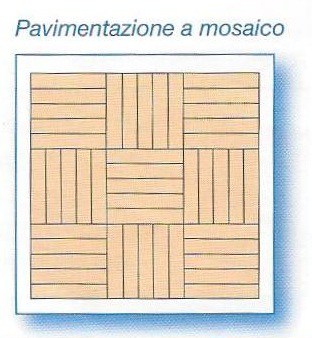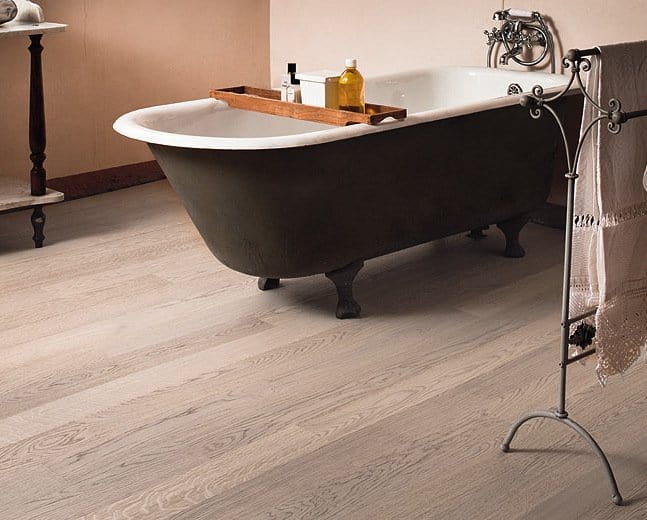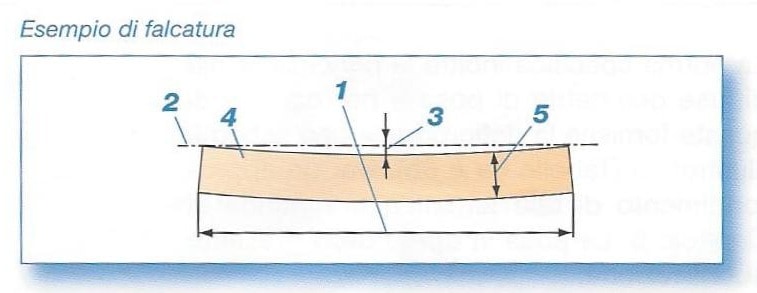Wood Flooring definition
Parquet definitions: technical glossary and terms, parquet types for wood flooring laying
There definition of parquet helps to understand what is meant by real wooden floor and how many types of parquet (starting from the types of parquet laying) there may be.
We expose on this page the terminology and the technical glossary of parquet , to help you better understand the meaning of some terms (for example the hardness of the parquet and its resistance to wear), also with regard to any parquet problems (arched, sickle, embarked), and above all with regard to the types of parquet distinct for types of parquet laying (French, ship deck, regular quarterdeck, herringbone, Hungarian, mosaic).
If you are looking for the distinction of parquet for glued, nailed and floating installation (floating) , find out more about these differences on the page dedicated to laying the parquet .
In any case, our technicians have the competence, experience and courtesy to clarify all your doubts, even just by phone, and, if you are interested, to send you a free parquet sample to your home in just 48/72 hours. . Without any commitment, do not hesitate to contact us !
Parquet definition: terminology and technical glossary
Regarding the terminology and definitions of the parquet and wooden flooring, reference is made to what is indicated in the standard UNI EN 13756 Wood flooring Terminology .
The standard, which cancels and replaces the Italian standard U40.05.259.0: 1999 “Elements of wood for flooring Terminology”, identifies terms and definitions, essential to allow operators in the sector to speak a common and homogeneous language.
In particular, some important definitions are recalled below, useful for clarifying what is meant by parquet , for wooden flooring, by element, by multilayer element, for glued, floating or nailed laying, etc. (Table 2).
Main terms and definitions parquet reported in the UNI EN 13756 standard
| TERMS | DEFINITIONS |
|---|---|
| Parquet | Wooden flooring with a minimum top layer thickness of 2.5 mm before laying (conventional definition) |
| Wood flooring | Assembly of individual wooden elements placed on the primary structure or on the sub-floor |
| Underfloor or false floor | Non-continuous / continuous support system between the wooden flooring and the primary structure |
| Boarding | Semi-finished wood product that can be laid as a false floor |
| Element | The smallest single piece or the smallest piece as delivered before laying |
| Flooring board | without edges and / or profiled heads, able to be assembled with other similar elements |
| Pre-assembled flooring board | Flooring board made from single elements by gluing the edges and / or heads |
| Multilayer element | Laminated construction element consisting of a top layer of solid wood and one or more additional layers of wood, or wood-based materials, glued together |
| Parquet list | Narrow and generally short flooring element |
| Element with assembly system | Element with an assembly system, with a thickness that makes it suitable for installation on a continuous support surface |
| Parquet panel | Pre-assembled installation unit consisting of elements for flooring |
| Mosaic parquet slat | Small, rectangular shaped solid wood element with smooth edges |
| Element without interlocking | Small parquet element with smooth edges |
| Bindello (or frame list) | A shaped piece of wood intended to form the frame of a wooden floor or to form a joint between different types of flooring |
| Female | Continuous groove |
| Note: when it is practiced along the edge and / or the head of an element, it is intended to receive a male; when it is practiced on the counter face it is for technical reasons | |
| Male | Continuous protruding curb, obtained along the edge and / or the head of an element |
| Note: there are two types of taps: integrated and independent.The second type is used to join grooved elements edge (head) to edge (head) | |
| Installation measure | Measure of the element, represented by the face after laying, expressed as a unit of surface |
| Laying unit | Pre-assembled elements that are placed edge to edge and / or head to head to form a repeatable pattern and which are held together by a suitable material (rigid or semi-rigid) on the face or counter face to facilitate transport and installation |
| Floating pose | Any installation system that allows each element to be fixed to the others but to be independent from the underlying surface |
| Installation with nailing / screwing | Installation system that allows the elements to be fixed to any support structure by applying nails or screws |
| Laying with hidden nailing | Nailing or screwing through the male or female so that they can be covered from the upper side |
| Installation with gluing | Installation system that allows the elements to be fixed to the underlying surface with adhesives |
| Demountable floor / demountable parquet | Pre-assembled wooden flooring panels that can be easily assembled and disassembled to form a temporary floor |
Parquet technical glossary
ALBURNO: it refers to the outermost part of the trunk and has a “whitish” color. It can be easily attacked by fungi and insects which, normally, they come eliminated during the drying phase of the wood.
BLUEING: we mean an alteration of the wood of a greyish color with bluish shades, caused by attacks of particular fungi. This imperfection does not change the mechanical resistance of the wood species.
HARD Z ZA: indicates the resistance that a material opposes to its penetration. It is important both for woodworking (cutting and sanding) and for the effect that on the flooring can cause various kinds of impacts, caused by accidental fall of materials, the effect of stiletto heels, etc.
The most common methods for determining hardness are:
Method J to nec: consists in identifying the load necessary to make a steel hemisphere completely penetrate the wood having surface of l cm ‘. The value is indicated in kq / crn ‘
M. Brine method L L: measures the diameter of the circular imprint left in the wood by a steel sphere (generally 10 mm in diameter) loaded with a load varying from 10 to 100 kg depending on the hardness of the wood (on average 50 kg are loaded). Hardness is expressed in Kgjmm2
DURABILITY: is the ability of wood to resist alterations provoked from fungi and insects. It depends on particular substances present above all in the heartwood (internal part of the trunk) which determine its resistance. t’albume (external part of the trunk) is easily attacked as it contains nutrients for fungi and insects.
FIBRATU R. TO: we mean the direction of the anatomical elements present in a stem or in semi-finished products and can be intertwined, wavy, deviated, irregular.
GLOSS: means the unit of measurement of the brightness of the paints, detectable with a suitable instrument and indicates the reflection of light according to a determined angle of incidence.
THE DRORE PELLENZA : we mean a treatment that has the primary purpose of improving resistance to humidity, water and variable environmental conditions.
ICiNORITARDANCE : it has the specific purpose of increasing the reaction time of wood to fire, in order to have the possibility to put out a possible fire.
BOAT : we mean the deformation of an element in the direction of the width of the face and can be concave or convex.
OXIDATION : we mean the term used to indicate the natural variation of wood, due to exposure to air and light, especially for the action of ultraviolet rays.
SPECIFIC WEIGHT: we mean the ratio between the mass of the wood and its volume. A volumetric mass of 800 Kq / rn ‘, at a humidity of 12, means that the m’ of wood containing 12 of humidity, weighs 800 Kg.
RESISTANCE TO WEAR : is the behavior of the surface when it comes into contact with other moving bodies such as, for example, the soles of shoes, wheelchairs, etc.
SWELLING : we mean the dimensional variation of the wood caused by an absorption of humidity.
WITHDRAWAL: we mean the dimensional variation of the wood caused by a release of humidity.
SPECIFIC WITHDRAWAL : we mean the dimensional variation in which the wood undergoes for each liter of lost moisture.
BRISTLE : we mean the cracking of the wood which normally develops longitudinally and fairly narrow, shallow and limited in length.
MIRROR : we mean an aggregate of cells arranged radially in the wood, which give rise to more “shiny” areas. This characteristic, present in particular in oak, is not a defect but a characteristic of the “first choice”.
VAPORIZATION: the treatment is carried out with the addition of steam and is useful for giving the wood certain effects such as color variations, better plastic behavior, workability, hardness.
Parquet technical problems
Arched parquet (Arched)
LEGEND
1 Length h ezz to
2 Face the to
3 TO rcua t ura
4 B. ord or
5 Thick or king
Definition
Deformation of an element lengthwise perpendicular to the face. 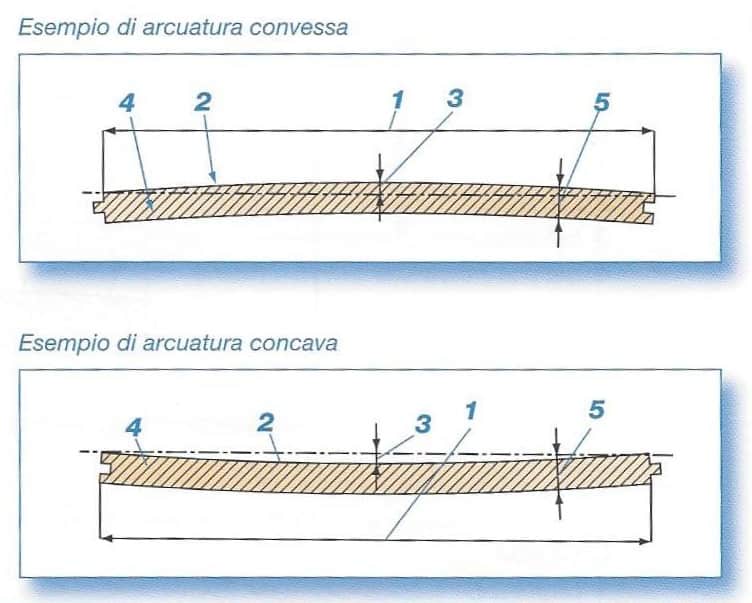
Scythed parquet (Falcatura)
LEGEND
1 Length h ezz to
2 Reference line
3 Falc to t ura
4 Face
5 Width
Definition
Deformation of an element lengthwise perpendicular to the edge.
Embarked parquet (Boat)
LEGEND
1 Width
2 Face
3 Crafting
4 Cross section
Definition
Deformation of an element along the width of the face. 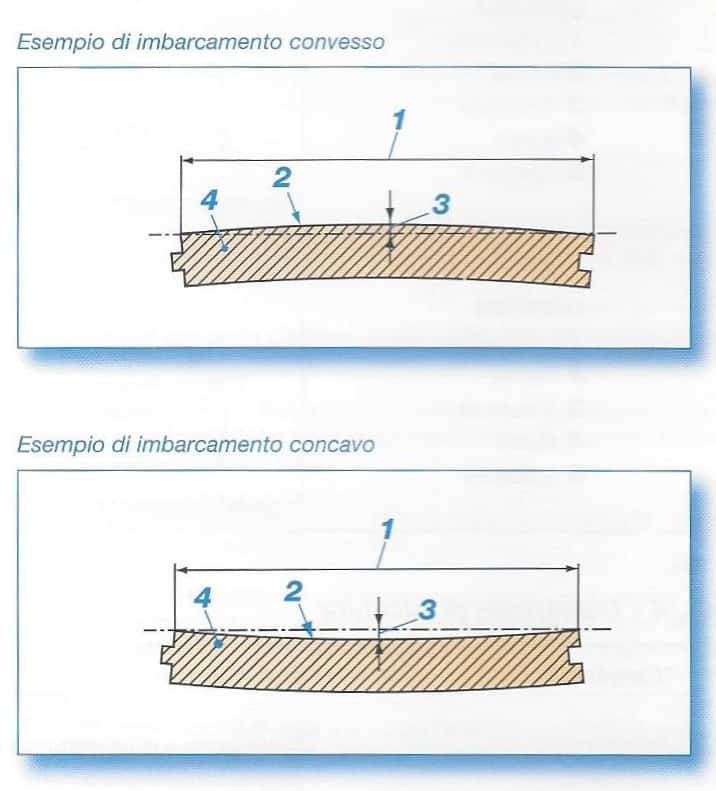
Parquet types for types of parquet laying
The standard also specifies the main and most common laying geometries and for each of these it provides the definition and an illustrative scheme (Tables 6a and 6b).
French parquet
French term Definition Parquet consisting of elements with different and random lengths and a series of widths, arranged in direction
parallel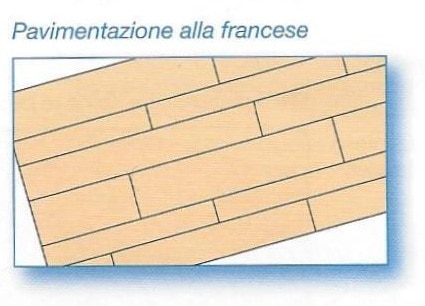
Ship deck or running parquet
Term to the deck of a ship or to racing Definition Parquet consisting of an assembly of equal lists
random width and length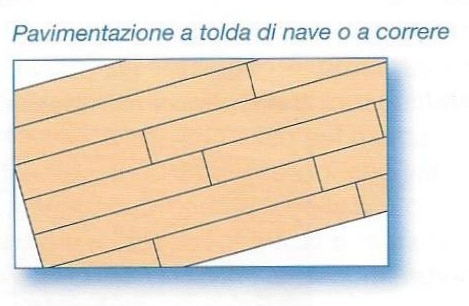
Regular formwork parquet
Term regular formwork Definition Parquet consisting of elements of equal length and width,
where the butt joint is at the center of the juxtaposed elements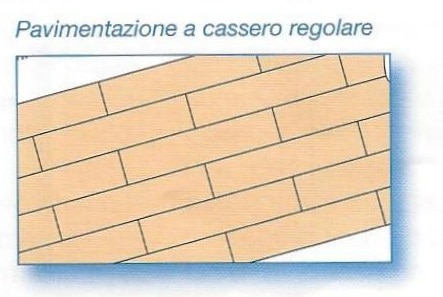
Herringbone parquet
Term herringbone Definition Parquet consisting of elements with the same dimensions, having
heads cut at right angles, laid perpendicularly between
them, at an angle of 45 ° in relation to the directions of the walls
and / or moral / magatelli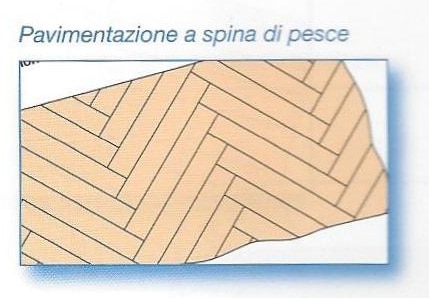
Hungarian parquet
Term in Hungarian
Definition Parquet consisting of elements with the same dimensions, having
heads cut at an angle between 45 ° and 60 °, which are placed head to head at a right angle or at an angle of 120 °, forming parallel patterns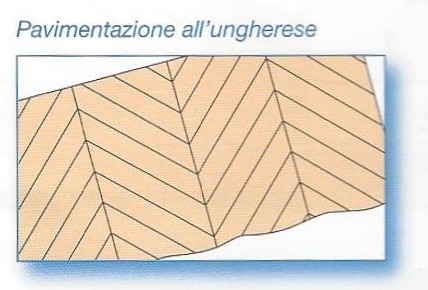
Mosaic parquet
Mosaic term
Definition Assembly of slats, blocks or strips positioned on the edge
against edge and forming a square whose side is equal to
length of the lamella, block or strip.